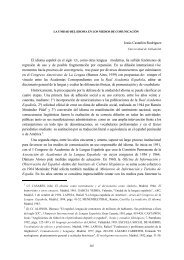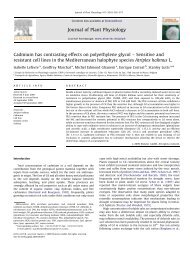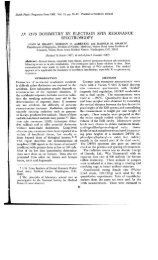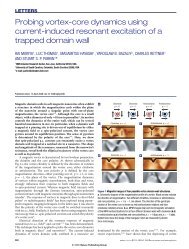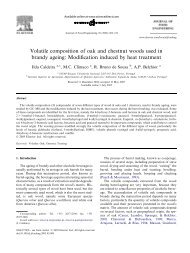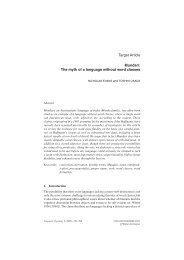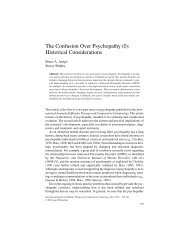Terpenoids: Opportunities for Biosynthesis of Natural Product Drugs ...
Terpenoids: Opportunities for Biosynthesis of Natural Product Drugs ...
Terpenoids: Opportunities for Biosynthesis of Natural Product Drugs ...
Create successful ePaper yourself
Turn your PDF publications into a flip-book with our unique Google optimized e-Paper software.
eviews Ajikumar et al.<br />
has begun to re-explore the various aspects <strong>of</strong> secondary<br />
metabolite natural products as evident by the abundance <strong>of</strong><br />
recent review articles in prominent journals. 1–32<br />
<strong>Natural</strong> products have undergone the evolution process <strong>for</strong><br />
a specific purpose <strong>of</strong> interacting within a biological system,<br />
as attractants, repellents, defenses, and a host <strong>of</strong> other<br />
important ecological functions. These molecules efficiently<br />
interact with proteins, DNA, and other biological molecules<br />
in nature to produce a desired outcome, which could be<br />
exploited <strong>for</strong> the future design <strong>of</strong> natural products-derived<br />
therapeutics. Thus by sampling drug candidates from natural<br />
(5) Yin, J.; Straight, P. D.; Hrvatin, S.; Dorrestein, P. C.; Bumpus,<br />
S. B.; Jao, C.; Kelleher, N. L.; Kolter, R.; Walsh, C. T. Genomewide<br />
high-throughput mining <strong>of</strong> natural-product biosynthetic<br />
gene clusters by phage display. Chem. Biol. 2007, 14, 303–312.<br />
(6) Ekins, S.; Mestres, J.; Testa, B. In silico pharmacology <strong>for</strong> drug<br />
discovery: applications to targets and beyond. Br. J. Pharmacol.<br />
2007, 152, 21–37.<br />
(7) Christianson, D. W. Roots <strong>of</strong> Biosynthetic Diversity. Science<br />
2007, 316, 60–61.<br />
(8) Pichersky, E.; Noel, J. P.; Dudareva, N. <strong>Biosynthesis</strong> <strong>of</strong> Plant<br />
Volatiles: Nature’s Diversity and Ingenuity. Science 2006, 311,<br />
808–811.<br />
(9) Clardy, J.; Walsh, C. Lessons from natural molecules. Nature<br />
2004, 432, 829–837.<br />
(10) Demain, A. L.; Fang, A. The natural functions <strong>of</strong> secondary<br />
metabolites. AdV. Biochem. Eng. Biotechnol. 2000, 69, 1–39.<br />
(11) Raab, R. M.; Tyo, K.; Stephanopoulos, G. Metabolic engineering.<br />
AdV. Biochem. Eng. Biotechnol. 2005, 100, 1–17.<br />
(12) Khosla, C.; Keasling, J. D. Metabolic engineering <strong>for</strong> drug<br />
discovery and development. Nat. ReV. Drug DiscoVery 2003, 2,<br />
1019–1025.<br />
(13) Giddings, G.; Allison, G.; Brooks, D.; Carter, A. Transgenic<br />
plants as factories <strong>for</strong> biopharmaceuticals. Nat. Biotechnol. 2000,<br />
18, 1151–1155.<br />
(14) Watts, K. T.; Mijts, B. N.; Schmidt-Dannert, C. Current and<br />
emerging approaches <strong>for</strong> natural product biosynthesis in microbial<br />
cells. AdV. Synth. Catal. 2005, 347, 927–940.<br />
(15) Klein, M. D.; Ajikumar, P. K.; Stephanopoulos, G. Engineering<br />
microbial cell factories <strong>for</strong> biosynthesis <strong>of</strong> isoprenoid molecules:<br />
beyond lycopene. Trends Biotechnol. 2007, 25, 417–424.<br />
(16) Chang, M. C.; Keasling, J. D. <strong>Product</strong>ion <strong>of</strong> isoprenoid pharmaceuticals<br />
by engineered microbes. Nat. Chem. Biol. 2006, 2,<br />
674–681.<br />
(17) Watts, K. T.; Lee, P. C.; Schmidt, D. C. Exploring recombinant<br />
flavonoid biosynthesis in metabolically engineered Escherichia<br />
coli. ChemBioChem 2004, 5, 500–507.<br />
(18) Das, S.; Rosazza, J. P. Microbial and enzymatic trans<strong>for</strong>mations<br />
<strong>of</strong> flavonoids. J. Nat. Prod. 2006, 69, 499–450.<br />
(19) Withers, S. T.; Keasling, J. D. <strong>Biosynthesis</strong> and engineering <strong>of</strong><br />
isoprenoid small molecules. Appl. Microbiol. Biotechnol. 2007,<br />
73, 980–990.<br />
(20) Maury, J.; Asadollahi, M. A.; Møller, K.; Clark, A.; Nielsen, J.<br />
Microbial isoprenoid production: an example <strong>of</strong> green chemistry<br />
through metabolic engineering. AdV. Biochem. Eng. Biotechnol.<br />
2005, 100, 19–51.<br />
(21) Fecik, R. A. <strong>Natural</strong> product biosynthesis moves in vitro. Nat.<br />
Chem. Biol. 2007, 3, 531–532.<br />
(22) Gershenzon, J.; Dudareva, N. The function <strong>of</strong> terpene natural<br />
products in the natural world. Nat. Chem. Biol. 2007, 3, 408–<br />
414.<br />
168 MOLECULAR PHARMACEUTICS VOL. 5, NO. 2<br />
products, it allows the investigator to select the desired subset<br />
<strong>of</strong> chemical diversity that is known to interact with biological<br />
systems.<br />
To better understand the impact <strong>of</strong> natural products on<br />
pharmaceuticals, one can look at our current arsenal <strong>of</strong> small<br />
molecule chemotherapeutics. Out <strong>of</strong> 155 small molecules<br />
used as chemotherapeutics, 47% are directly taken from the<br />
natural products and an additional 26% are derivatives or<br />
synthetic natural product mimics. 33 In contrast to this<br />
apparent dominance <strong>of</strong> natural products in pharmaceuticals,<br />
over the last two decades synthetic combinatorial chemistry<br />
and associated high throughput drug discovery screening<br />
yielded only one de noVo chemical which was approved <strong>for</strong><br />
drug use. Hence, it is not surprising that the current chemicalbased<br />
drug discovery is now focusing on introducing<br />
structural and chemical diversity to natural product scaffolds<br />
to identify novel therapeutic molecules. 34<br />
Technological advancements made through genomics and<br />
systems biology research have put <strong>for</strong>ward a new paradigm<br />
in natural products discovery and biosynthesis. 1,3,15,20,28,29<br />
<strong>Natural</strong> products discovery can now be aided by the wealth<br />
<strong>of</strong> genomic sequence in<strong>for</strong>mation that has become available.<br />
By combining the genomic in<strong>for</strong>mation with the ecological<br />
mechanisms by which these natural products work, bioin<strong>for</strong>matics<br />
approaches can begin to predict a list <strong>of</strong> possible<br />
interactions <strong>of</strong> these molecules with biomolecules in humans.<br />
This in<strong>for</strong>mation will be valuable, to predict both mechanisms<br />
<strong>of</strong> activity against disease and toxic side effects.<br />
Supported by omics technologies, metabolic engineering<br />
and synthetic biology now allow the manipulation and<br />
(23) Konig, H. G. G. M. <strong>Terpenoids</strong> from marine organisms: unique<br />
structures and their pharmacological potential. Phytochem. ReV.<br />
2006, 5, 115–141.<br />
(24) Ishida, T. Biotrans<strong>for</strong>mation <strong>of</strong> terpenoids by mammals, microorganisms,<br />
and plant-cultured cells. Chem. BiodiVersity 2005,<br />
2, 569–590.<br />
(25) Pichersky, E.; Noel, J. P.; Dudareva, N. <strong>Biosynthesis</strong> <strong>of</strong> plant<br />
volatiles: nature’s diversity and ingenuity. Science 2006, 311,<br />
808–811.<br />
(26) Memelink, J. The use <strong>of</strong> genetics to dissect plant secondary<br />
pathways. Curr. Opin. Plant Biol. 2005, 8, 230–235.<br />
(27) Harvey, A. L. <strong>Natural</strong> products as a screening resource. Curr.<br />
Opin. Chem. Biol. 2007, 11, 480–484.<br />
(28) Paterson, I.; Anderson, E. A. Chemistry. The renaissance <strong>of</strong><br />
natural products as drug candidates. Science 2005, 310, 451–<br />
453.<br />
(29) Schewe, H.; Pescheck, M.; Sell, D.; Schrader, J. Biotechnological<br />
production <strong>of</strong> terpenoid flavour and fragrance compounds in<br />
tailored bioprocesses. DeV. Food Sci. 2006, 43, 45–48.<br />
(30) Roberts, S. C. <strong>Product</strong>ion and engineering <strong>of</strong> terpenoids in plant<br />
cell culture. Nat. Chem. Biol. 2007, 3, 387–395.<br />
(31) Schmidt, B. M.; Ribnicky, D. M.; Lipsky, P. E.; Raskin, I.<br />
Revisiting the ancient concept <strong>of</strong> botanical therapeutics. Nat.<br />
Chem. Biol. 2007, 3, 360–366.<br />
(32) Katz, L.; Chaitan, K. Antibiotic production from the ground up.<br />
Nat. Biotechnol. 2007, 25, 428–429.<br />
(33) Newman, D. J.; Cragg, G. M. <strong>Natural</strong> products as sources <strong>of</strong><br />
new drugs over the last 25 years. J. Nat. Prod. 2007, 70, 461.<br />
(34) Ganesan, A. <strong>Natural</strong> products as a hunting ground <strong>for</strong> combinatorial<br />
chemistry. Curr. Opin. Biotechnol. 2004, 15, 584–590.



